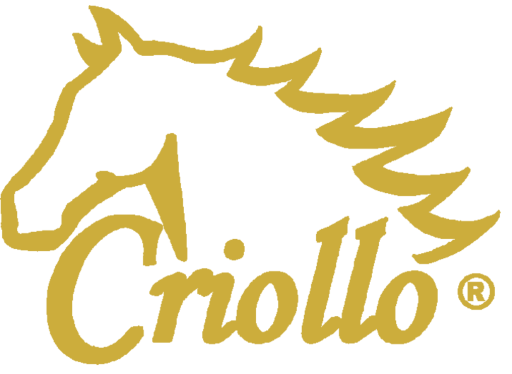Information about the ingredients, other important feeding issues and product packaging
Product packaging
All Criollo jar product packages and measuring cups are recyclable plastic and the handles are recyclable metal.
Basic information about ingredients - food grade or pharmaceutical grade?
The majority of our supplements use food-grade raw materials – in joint supplements, all ingredients are food grade, that come from Finland's and Europe's large and reputable suppliers.
Why is food grade safer to use than pharmaceutical grade?
Food-grade ingredients are intended for everyday use and their limit values are much stricter (e.g. heavy metals) than in pharmaceutical grade ingredients, which are intended for short-term/curative use and to be taken only in very small amounts at a time, so that the above-mentioned substances wouldn't cause problems. Thus, food grade is much safer for everyday, continuous use.
Criollo supplements use natural products, so the color differences between the product batches may vary.
Fillers or not?
CRIOLLO JOINT SUPPLEMENTS DO NOT CONTAIN ANY FILLERS, for example:
- aqua/water
- fish oil/ other oil
- glycerol = alcohol
- sakkaroosi = ruokosokeri, tav. sokeri
- glucose
- fructose
- lactose
- dextrose
- inulin = storage polysaccharide formed from fruit sugar
- maltodextrin = starch
- corn starch
- palatinose = carbohydrate
- green flour
- wheat bran
- rice bran
- rice flour
- oat flour
- oatmeal
- feed rye flour
- yeast
Criollo joint supplements contain only ingredients that affect the joints!
Basic ingredients in Criollo joint supplements are glucosamine, chondroitin sulfate, hyaluronic acid and MSM, which are already naturally present in the horse's joints, but the production of which in the body decreases with age and during heavy exertion the joints get strained and the above-mentioned substances are necessary for the joints. Of these, chondroitin sulfate and hyaluronic acid are joint "oils" that lubricate the joint.
Joint supplements
Joint supplement negatives:
– it takes about a month before it starts to work, if joint nutrients have not been fed before
Joint supplement positives:
+ efficient in continuous use
+ long-term effect
+ can also be fed preventively and also to young individuals, e.g. with a smaller dosage
+ contains substances naturally found in the joints, e.g. glucosamine, chondroitin sulfate, collagens and hyaluronic acid
+ no doping caution period
+ safe to use
+ easy to use
Fish oil or not?
According to the latest research, heavy and regular use of fish oil can be dangerous for the liver; causes unfavorable effects in the functioning of liver cells and can also cause fatty liver disease (abundant accumulation of fat inside liver cells).
Criollo products do not use fish oils.
Criollo joint supplements' ”oils” are chondroitin sulfate and hyaluronic acid and they are the joint's natural "oils" that lubricate the joint.
Yeast or lactic acid bacteria?
The latest research has found that the use of brewer's yeast in horse feeding is more beneficial than lactic acid bacteria.
The use of lactic acid bacteria in horses is questionable because there is no research on their effect on the functioning of the horse's stomach; lactic acid bacteria work when they are aimed at a specific problem, but when it is not known what lactic acid bacteria should be fed, feeding them to the horse is pointless. In humans, on the other hand, the use of lactic acid bacteria is a precise treatment, when you know what helps what.
Brewer's yeast (Saccharomyces cerevisiae) has been found to help the horse's stomach function, see paragraph brewer's yeast.
Starch and sugar
When giving a horse solid feed, it would be important to avoid a large amount of starch - and sugar, that's why several feedings a day are important. As the size of the feed portions increases, the passage of food through the intestines speeds up and the digestibility of starch and sugar decreases. If the amount of feed at one time is too large, the food passes through the intestines faster and the starch and sugar are digested more poorly. Most of the starch and sugar in the horse's food is broken down during digestion in the small intestine. If there is too much starch and sugar at one time, the excess is transported to the large intestine, which can result in e.g. overweight, stomach ulcer, foot-and-mouth disease, lumbar paralysis, symptoms of constipation, diarrhea and, in addition, normal bowel movements and water absorption from the intestines can be disturbed.
Glucosamine
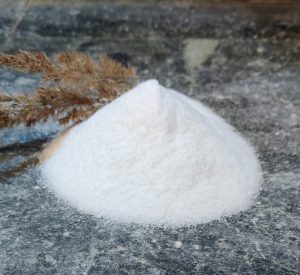
Glucosamine is a naturally occurring substance in joints and cartilage that decreases with age and is therefore used to prevent joint degeneration and maintain joint health. Glucosamine increases cartilage health, protects articular cartilage from degeneration and inhibits the activity of enzymes that destroy cartilage. Glucosamine maintains optimal joint function and well-being, slows down the development of osteoarthritis and supports joint rehabilitation. The use of glucosamine increases the glucosamine content of synovial fluid. About 90% of glucosamine taken orally is absorbed.
Glucosamine comes from shellfish.
Hyaluronic acid
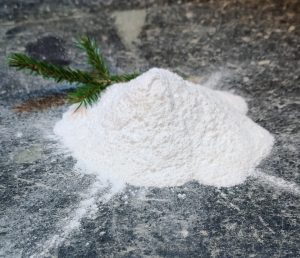
Cartilage tissue and synovial fluid contain a particularly large amount of hyaluronic acid, which absorbs water and thus gains elasticity and is important for the viscous and elastic properties of synovial fluid. Hyaluronic acid acts as a lubricating and shock-absorbing substance in normal joints and softens the impacts on the joints. Hyaluronic acid is a normal component of synovial fluid, the amount of which decreases in inflammation. Hyaluronic acid lubricates the joint, maintains normal fluid balance, restores its function to normal and improves joint mobility. Hyaluronic acid is also an important building block of cartilage tissue.
We use over 90% hyaluronic acid in all our joint supplements.
Collagen UC-II®
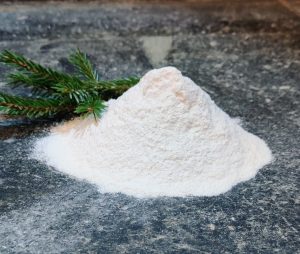
UC-II® (InterHealth Nutraceuticals) is a new proprietary ingredient – undenatured (the collagen has not been heated or treated with chemicals) type II collagen derived from chicken sternum cartilage, which allows for the development of smaller dosage forms. UC-II® is supported by four published clinical studies examining joint comfort, mobility and flexibility. UC-II® is sourced and manufactured in the USA in an NSF certified GMP facility. It is both NDI (FDA Notified and Released New Nutrients) and GRAS (generally recognized as safe) – it is safe to use with rare or mild side effects and non-GMO (non-genetically modified). After its initial research, InterHealth has continued systematic scientific support around this ingredient. The effectiveness, safety and quality of UC-II® have been carefully studied. Controlled studies (RCT) show that 40 mg of UC-II® once a day supports joint comfort, mobility and flexibility. UC-II® can be used alone or with other substances that affect the well-being of the joints, e.g. hyaluronic acid and curcumin.
According to the information received from the manufacturer of collagen UC-II®, UC-II® and hyaluronic acid (HA) do not cancel each other's effect, but work excellently together in the same product! "We are not aware of any interaction between Hyaluronic acid and UC-II which would be negative. It is used in other products so should be totally fine" According to the manufacturer of UC-II®, even glucosamine and chondroitin sulfate, despite some claims, do not reverse the effect of UC-II® "We don't have any evidence that the two ingredients - Glucosamine and Chondroitinsulfate – would have canceled each other out. They work via different mechanisms than UC-II so there should be no reason to assume that they would prevent one another working.”
Cartilage is largely composed of type II collagen fibers. The oral supplement improves the well-being of the joints and keeps them mobile for longer.
Collagens I and II
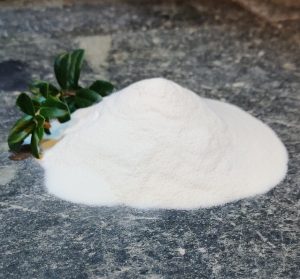
Collagens need to be broken down into amino acids so that they can be transported to the affected areas. Collagens are processed, as if "pre-digested", into amino acid chains, resulting in an easily digestible and absorbable product, collagen hydrolyzate, which breaks down in the body into amino acids and bioactive collagen peptides. The horse's long digestion time facilitates absorption.
Collagens activate the body's own collagen production when used internally.
Due to their high tensile strength, collagens give tissues mechanical resistance.
type I collagen, which forms long strands in the cell medium, is the most common protein collagen in the body; it is especially found in bone, but also in tendons, ligaments and the dermis of the skin.
Cartilage, on the other hand, is largely composed of type II collagen fibers; type II helps prevent cartilage deterioration. Especially optimized bioactive collagen peptides promote the growth of cartilage structures and thus resist the wear and tear caused by aging and extra load. Thus, the oral supplement improves the health of the joints and keeps them mobile for longer.
Criollo products use bioactive collagens.
Chondroitin sulfate
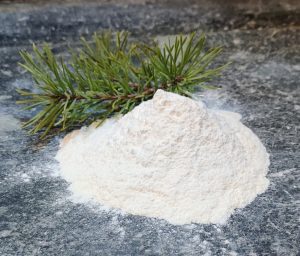
Chondroitin sulfate is a naturally occurring substance in joints; one of the main building materials of cartilage, which binds water to the cartilage tissue. Synovial fluid contains a lot of gel-like hyaluronic acid and chondroitin sulfate, which fill the empty spaces of the joints.
Chondroitin sulfate acts as a shock absorber and lubricant that treats joints. Chondroitin sulfate improves the mobility of the diseased joint, reduces joint cartilage loss and slows down the progression of osteoarthritis.
In all our joint supplements, where we use chondroitin sulfate, it is over 90% and derived from beef.
Turmeric (Curcuma longa)
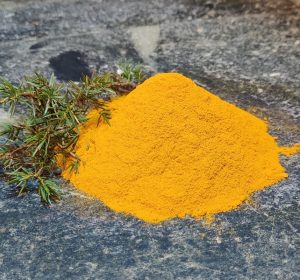
Turmeric belongs to the ginger plants and its rhizome contains curcuminoids. Turmeric is also rich in essential oil.
One of the significant uses is also various stomach ailments. Turmeric helps with loss of appetite, indigestion and hyperacidity of the stomach. Turmeric stimulates the secretion of digestive fluids and helps with all stomach ailments and also reduces the formation of intestinal gases.
Turmeric has received the name "natural cortisone". Turmeric's curcumin is also helpful in musculoskeletal diseases, e.g. in support of joint diseases.
Turmeric is antibacterial and a strong antioxidant, which weakens e.g. the viability of various bacteria, viruses and yeasts. Also helps with skin problems. Researchers have shown that curcuminoids can effectively control inflammation, which supports the use of turmeric in folk medicine for the treatment of rheumatism, arthritis, eczema (rash), asthma, psoriasis and other inflammatory diseases.
Turmeric works synergistically with ginger, which enhances the absorption of turmeric up to 20 times.
Lecithin
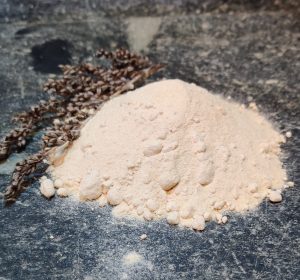
Lecithin contains a lot of phospholipids and unsaturated fatty acids (linoleic and linolenic acid, also known as Omega-3 and Omega-6). These fats are very important for cell function. Lecithin is also a valuable supplement for reducing stress.
Lecithin is also excellent for horses exposed to or suffering from stomach ulcers, as it neutralizes stomach acids. Lecithin strengthens the hydrophobic (water-repellent) surface layer of the intestine; lecithin protects the stomach lining.
Our products use soy lecithin, which is GMO-free (not genetically modified).
MSM
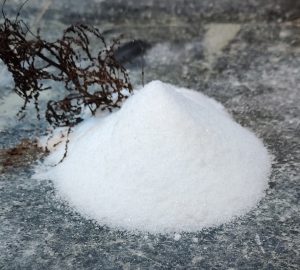
MSM (methylsulfonyl methane or organic sulfur) helps to maintain the natural functioning of muscles and joints and well-being. Sulfur is an essential part of producing good and healthy cells, it accelerates the metabolism and thus promotes tissue health and regeneration.
MSM is a naturally occurring sulfur compound found in small amounts in the body. It maintains joint mobility and supports many structures (their flexibility) and functions in the body, e.g. connective tissues, heart, blood vessels and the body's energy production. In addition, MSM also helps with digestive disorders, relieves muscle soreness and accelerates the healing of muscle injuries, promotes the health of the skin, coat and hooves.
Brewer's yeast (Saccharomyces cerevisiae)
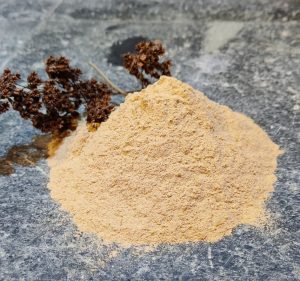
Brewer's yeast (Saccharomyces cerevisiae) is good for horse digestion. By adding yeast to the feed of a horse fed with highly starchy feed, the decrease in intestinal pH and the fluctuation of lactic acid content can be reduced. With the help of yeast, the horse tolerates starchy feeding better without developing a nutritional disorder in its system, because the yeast uses part of the starch for its own growth. Adding yeast to the horse's feed reduces the number of aerobic bacteria, a high number of these bacteria has been associated with disorders of the digestive tract.
Saccharomyces cerevisiae yeast has been found to stimulate and balance the growth of microbes in the rest of the intestine (caecum and colon) and promote fiber breakdown. In terms of a horse's digestion, the well-being of the microbiota is important; without a microbiome, the horse could not use the substances of the plant's cell wall for food. In addition, the microbiome protects the body, releases microbial protein for use by the horse when it dies, and produces B group vitamins and vitamins C and K and increases immunity.
It is good to add yeast to the feed, since it improves the digestibility of the fiber. It is believed that the yeast facilitates the digestion of fibers and stimulates the growth of bacteria, thereby increasing the breakdown of feed. Yeast also improves the digestibility of protein and increases the absorption of nutrients (e.g. calcium and phosphorus).
Yeast versus lactic acid bacteria
Research has recently shown that the use of yeast in horse feeding is much more beneficial than lactic acid bacteria, whose effect on the functioning of the horse's stomach has not been studied. The effect of lactic acid bacteria has been studied in humans and they can be used for specific treatment, because their use requires knowing which lactic acid bacteria to use and for what purpose. And this is not known for horses, so feeding lactic acid bacteria is pointless. Instead, yeast has been found to be really useful in horse nutrition.
Psyllium
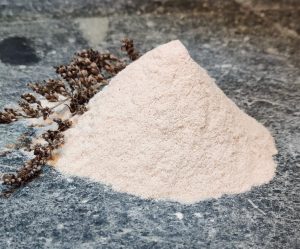
Criollo Psyllium is excellent for horses that eat sand, a very high fiber husk powder, 100% ispaghol husk obtained from the seeds of ispaghol (Plantago ovata). The husk powder swells very strongly, it binds 40 times its weight in water and thus becomes a gel mass when it gets wet, which carries the sand out. Also for constipation.
Nutrients %: moisture 8.0, crude protein 5.7, crude fat 2.3, crude fiber 4.6, crude ash 3.8
Rose hip (Rosa canina)
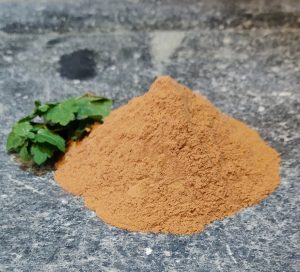
Rose hip is the vitamin C richest of all berries (1000 – 3000 mg/ 100 g) and it also has a lot of vitamin E. Rose hip contains e.g. bioflavonoids, antioxidants, amino acids, glucose, beta-carotene, copper, potassium, calcium, magnesium, zinc, iron, selenium, Omega-3 fatty acids, fluoride, vitamins A, K, D, B6, etc. Rose hip has traditionally been used to prevent anemia and has an immunity-enhancing property.
Rose hip is used effectively to maintain joint function and well-being. It has been found to effectively alleviate the symptoms of arthritis and osteoarthritis. Rose hip is an excellent addition to feeding, especially for old and stressed horses. The active substance is rosehip galactolipid, which curbs joint inflammation, improves mobility and reduces pain. Rose hip is the richest in vitamin C of all berries (1000 - 3000 mg/ 100 g). Vitamin C improves collagen production. Ruusunmarja on C-vitamiinirikkain kaikista marjoista (1000 – 3000 mg/ 100 g). C-vitamiini parantaa kollageenituotantoa.
Rose hips also contain pectin, which is a soluble fiber and promotes intestinal function by lubricating it and balancing the protective mucus layer. In addition to this, pectin stabilizes the protective stomach lining and raises the pH value of the stomach. Rose hip pectin, like other soluble plant fibers, is also known to have a mild cholesterol-lowering effect. Today, rose hip has been found to lower blood cholesterol levels, increase bile secretion and strengthen the liver. The essential oils of roses are anti-inflammatory and anti-microbial and improve tissue regeneration and increase bile. In addition, rose hip sorbitol prevents hyperacidity of the stomach and increases salivation. The cohesive property of pectin and lecithin (thick and protective gel) helps the fibers (Laminaria and Ispaghul) adhere to the mucous membrane. In tests, it has been possible to demonstrate accelerated healing of ulcers when feeding pectin and lecithin. Pectin and lecithin protect a stressed stomach.
Rose hip also helps with the quality of hooves, skin and hair. Rose hip is also used as a supportive treatment for hoof fever.
Sea buckthorn (Hippophae rhamnoides)
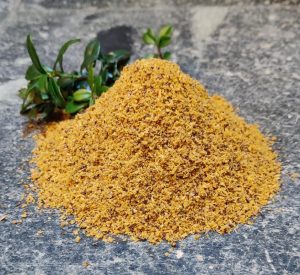
Sea buckthorn is really exceptionally rich in flavonoids, Omega oils and vitamins.
Sea buckthorn's flavonols are quercetin, myricetin, isorhamnetin and kaempferol, which affect e.g. the improvement of heart and liver function and immune response. The most flavonoids are found in the skin of the sea buckthorn and just below it.
The oil content of sea buckthorn pulp varies between 4-7%. No other berry has such a high oil content. Sea buckthorn seeds contain equally valuable oils, which can be separated from the seed in several different ways. Sea buckthorn oil is perhaps the most valuable ingredient of sea buckthorn, which contains e.g. oleic, stearic, linoleic, palmettoline and oleic acids. Vitamin E and cartenoid-rich palmettoline and linoleic oils are very favorable for fat metabolism. Palmettolic acid, which is important for skin health, is more than 30% in the berry flesh. More than 90% of the fatty acids contained in sea buckthorn are so-called essential Omega 3 fatty acids, which must be obtained daily. In addition, sea buckthorn also contains Omega 6, 7, and 9 fatty acids. Sea buckthorn seeds and fruit pulp contain polyunsaturated fatty acids that have beneficial health effects. Sea buckthorn contains linoleic and alpha-linolenic acid. The body converts linoleic acid into GLA, which is needed to maintain good hormone function. Sea buckthorn oils have a favorable effect on the structure of mucous membranes. In the berry, you get these fatty acids internally and they protect the whole body.
Sea buckthorn is extremely rich in vitamins; e.g. Vitamins C, E and B, as well as beta-carotene in very high concentrations. Sea buckthorn is a well-known source of health and well-being. Vitamin C promotes normal immune function, helps reduce fatigue and protects cells from oxidative stress. The very high vitamin E and flavonoid content make sea buckthorn an effective aid in supporting the immune system. Many other substances contained in the berry also promote the absorption of active substances. Vitamin C and flavonoids work better together than separately, as do vitamin C and E together and vitamin E and beta-carotene together.
Strong resistance and vitality from sea buckthorn:
* to support resistance
* for continuous, year-round use
* for seasonal use
* for intensive courses in acute need
* to combat fatigue
* as a versatile antioxidant for the whole body
* to treat inflammations
Sea buckthorn has a strengthening, astringent and antiseptic effect on mucous membranes. Its sea buckthorn oil is good for the skin, mucous membranes, heart, blood vessels, circulation and the body's defense system. Sea buckthorn contains fibers that support bowel function. Sea buckthorn contains plenty of highly effective antioxidants that destroy the most common free radical that causes inflammation and damages the heart muscle, kidneys, intestines and pancreas. The vitamins, pectin and substance compounds contained in sea buckthorn have a favorable effect on digestive diseases and stomach ulcers.
Yucca
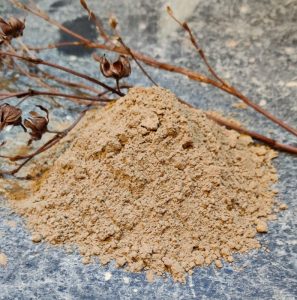
Yucca helps maintain the optimal pH value of the intestines in the digestive tract; the reduction of acidity has been found to contribute to health and vitality. Yucca helps to improve digestion and enables better absorption due to the acceleration of microbial activity in the intestines.
The saponins contained in yucca stimulate cell-mediated immunity and the formation of antibodies, enhancing local immunity. It has also been found to increase the effectiveness of food.
Yucca is rich in saponins that help nourish the joints. American Indians and Incas have used yucca for centuries for joint problems.
Yucca increases energy by releasing glucose in the liver, which helps maintain endurance during competitive performance.
